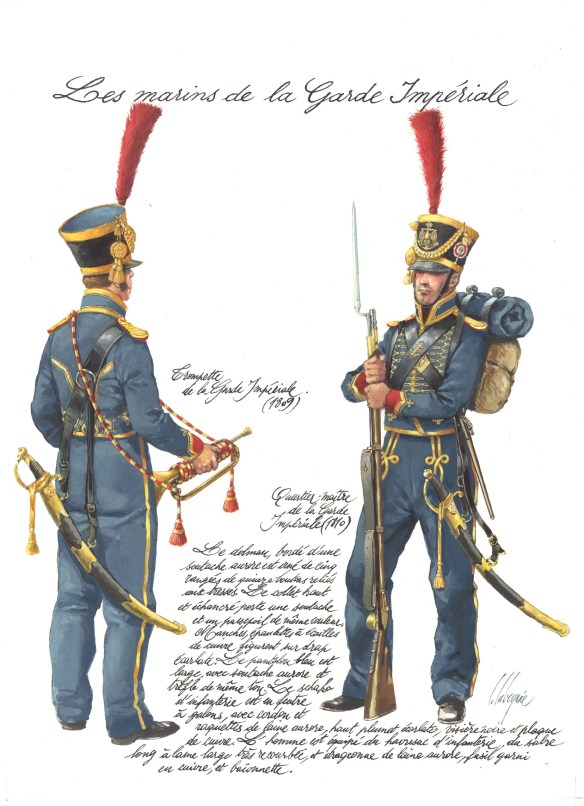One of the more unusual units in the French army was the Marins de la Garde. While we English speakers have a tendency to anglicize their title to “Marines of the Guard”, as most readers probably know, “marins” in French really means “sailors”, so these troops are more properly referred to as the Sailors of the Guard. Their history dates back to the Consulate. The original battalion was raised in September, 1803. It consisted of 5 equipages, each composed of composed of 125 matelots (another French word for sailors), 1 trumpeter, 15 craftsmen and NCOs, 5 ensigns and was commanded by a Naval Lieutenant. The entire battalion was commanded by a Naval Captain (capitaine de vaisseau). 120 men from the unit were part of Napoleon’s escort at his coronation in December, 1804.
The Sailors proved very flexible. In Napoleon’s own words, as quoted in Infantry of the Imperial Guard by Haythornwaite, “What should we have done without them? As sailors they have no way deteriorated, and they have shown themselves the best of soldiers. When occasion required they proved equally valuable, whether as sailors, soldiers, artillerymen or engineers; there was no duty they could not undertake.”
The corps d’élite of the new Imperial Army was, without the shadow of a doubt, the Imperial Guard. This celebrated formation evolved in a most haphazard and complicated fashion over the years, and here it will only be possible to mention the most important developments. Originally, it sprang from three sources—the personal escort (known as the Guides) of General Bonaparte commanded by Captain, later Marshal, Bessières, to which were added selected members of the Guards of the Directory and the Legislative Assembly. These three cadres were combined in late 1799 into the Consular Guard, and five years later underwent a final change of title in the year of the Emperor’s coronation. The Imperial Guard’s size grew enormously. At Marengo, the Consular Guard numbered only 2,089; by 1804 it had developed to comprise 5,000 grenadiers, 2,000 éite cavalry and 24 guns—or a total of some 8,000 soldiers in all; by mid-1805, this number had risen to over 12,000 men; no less than 56,169 Imperial Guardsmen were in service at the time of the Moscow campaign, but the all-time record was reached in 1814 when 112,482 soldiers could claim some type of membership of the Imperial Guard. Thus the corps d’élite developed from the size of a strong regiment to that of an army, but at the very end (“The Hundred Days”) it was down again to 25,870 soldiers.
The Imperial Guard eventually comprised three distinct sections. The original nucleus was the “Old Guard,” a force that eventually comprised foot grenadiers (the archtypical grognards) chasseurs, mounted grenadiers à cheval (known as grosse-bottes), the chasseurs à cheval (the “favored children”), dragoons, lancers, Mamelukes, gendarmes d’élite, besides Marines of the Guard and detachments of gunners and sappers. Then in 1806 was formed the embryo of what became known as the Middle Guard, made up initially of two fusilier regiments to which were eventually added (1812-13) two regiments of flankers, raised from gamekeepers and woodsmen, one and all noted as crack shots. Lastly, in 1809 there was founded the Young Guard, which mainly comprised regiments of light infantry, voltigeurs and tirailleurs. This last-mentioned formation consisted of the pick of each annual conscript class, and was a deliberate attempt to throw a more glamorous light onto the hated duties of compulsory military service; it was noted, however, that the Young Guard never fully attained the standard of the senior Guard formations.
The projected invasion of England brought about a new unit of the Consular (later Imperial) Guard on 17 September 1803: the Bataillon des matelots de la garde. They are nearly always called ‘Marines of the Guard’ in English, but the word matelot in French translates to ‘sailor’ in English. Calling them ‘Marines’ is understandable considering the very military appearance of these sailors, who wore shakos and were armed like elite soldiers. The battalion was 737 strong, divided into five crews. The unit soon marched away towards Ulm in 1805. In 1808 they were in Spain and many of the 300 present at Baylen were killed or wounded. Restructured and renamed Equipage des matelots de la Garde imperiale, and sent to the Danube in 1809, their strength was raised to 1,136 officers and men in 1810. They crossed the Niemen river into Russia in 1812, but only a third survived the terrible retreat. They then participated in the 1813 and 1814 campaigns. When disbanded on 30 June 1814, only 14 officers and 336 men were left. A small Equipage of 94, later 150, men was organised in the spring of 1815 but was disbanded after Waterloo on 15 August 1815.
